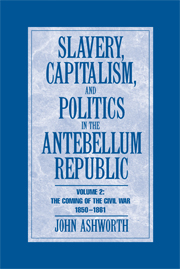Book contents
- Frontmatter
- Contents
- Acknowledgments
- Introduction: Explaining the Civil War (1)
- Part I Slavery versus Antislavery
- Part II Polarisation and Collapse
- 3 The disintegration of Democratic hegemony: Northern Democrats and their southern allies, 1850–1861
- 4 Political realignment: Collapse of the Whigs and neo-Whigs, 1848–1861
- Conclusion: Explaining the Civil War (2)
- Appendix: A review of some major works on the reasons for Confederate defeat
- Index
3 - The disintegration of Democratic hegemony: Northern Democrats and their southern allies, 1850–1861
Published online by Cambridge University Press: 05 June 2012
- Frontmatter
- Contents
- Acknowledgments
- Introduction: Explaining the Civil War (1)
- Part I Slavery versus Antislavery
- Part II Polarisation and Collapse
- 3 The disintegration of Democratic hegemony: Northern Democrats and their southern allies, 1850–1861
- 4 Political realignment: Collapse of the Whigs and neo-Whigs, 1848–1861
- Conclusion: Explaining the Civil War (2)
- Appendix: A review of some major works on the reasons for Confederate defeat
- Index
Summary
Introduction: The Kansas-Nebraska Act (1)
On January 4, 1854 Stephen A. Douglas, Senator from Illinois and Chairman of the Senate Committee on Territories, reported his bill for the organisation of what was then called the Nebraska territory. The bill went through many modifications, in the course of which the single territory became instead two. Douglas sought to employ the principle of popular sovereignty, by which the inhabitants of the two territories, Kansas and Nebraska, would be allowed to determine whether slavery would or would not be authorised. This principle had been central to the Compromise measures of 1850, measures with which Douglas himself had been closely identified and indeed for which he could claim considerable credit. Now, therefore, he determined that popular sovereignty, apparently a winning formula, should once again be applied.
The crucial difference, however, was that the Nebraska territory, acquired by Thomas Jefferson as part of the Louisiana Purchase, lay above the line of latitude at 36° 30′ and was thus, according to the Missouri Compromise of 1820–1821, barred to slavery. So Douglas's bill seemed to be at odds with the Missouri Compromise. Although he did not initially wish to be explicit, under pressure from other Senators he finally took the crucial step. He inserted a clause into his bill which declared that the Missouri Compromise, “being inconsistent with the principles of non-intervention by Congress with slavery in the States and Territories, as recognized by the legislation of 1850, is hereby declared inoperative and void.”
- Type
- Chapter
- Information
- Slavery, Capitalism and Politics in the Antebellum Republic , pp. 339 - 470Publisher: Cambridge University PressPrint publication year: 2007



